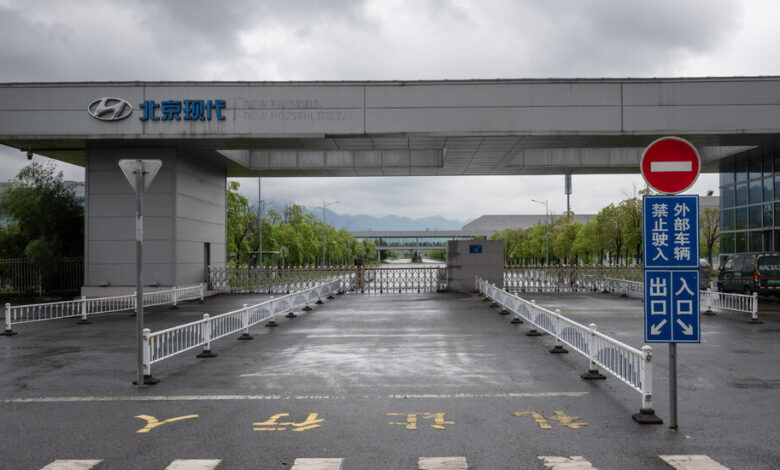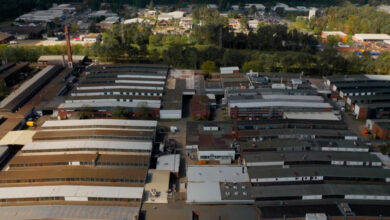‘It Is Desolate’: China’s Glut of Unused Car Factories

On the outskirts of Chongqing, western China’s largest city, sits a huge symbol of the country’s glut of car factories. It’s a complex of gray buildings, nearly a square mile in size. The thousands of employees who used to work there have moved on. Its crimson loading docks are closed.
The facility, a former assembly plant and engine factory, had been a joint venture of a Chinese company and Hyundai, the South Korean giant. The complex opened in 2017 with robots and other equipment to make gasoline-powered cars. Hyundai sold the campus late last year for a fraction of the $1.1 billion it took to build and equip it. Unmown grass at the site has already grown knee high.
“It was all highly automated, but now, it is desolate,” said Zhou Zhehui, 24, who works for a rival Chinese automaker, Chang’an, and whose apartment looks down on the former Hyundai complex.
China has more than 100 factories with the capacity to build close to 40 million internal combustion engine cars a year. That is roughly twice as many as people in China want to buy, and sales of these cars are dropping fast as electric vehicles become more popular.
Last month, for the first time, sales of battery-electric and plug-in gasoline-electric hybrid cars together surpassed those of gasoline-powered cars in China’s 35 largest cities.
Dozens of gasoline-powered vehicle factories are barely running or have already been mothballed.
The country’s auto industry is near the start of an E.V. transition that is expected to last years and eventually claim many of those factories. How China manages that long change will influence its future economic growth, since the auto sector is so big and could transform its work force.
The stakes are great for the rest of the world, too.
China, the world’s largest car market, became the largest exporter last year, having passed Japan and Germany. China’s auto sales abroad are exploding.
Three-quarters of China’s exported cars are gasoline-powered models that the domestic market no longer needs, said Bill Russo, an electric car consultant in Shanghai. Those exports threaten to flatten producers elsewhere.
At the same time, China’s electric vehicle companies are still investing heavily in new factories. BYD and other automakers are expected to introduce more electric models at the opening of the Beijing auto show on Thursday.
Electric car sales in China are still growing. But the pace of growth has halved since last summer, as consumer spending has faltered in China because of a housing market crisis.
“There is a slowdown trend, especially for pure electric vehicles,” said Cui Dongshu, secretary general of the China Passenger Car Association.
China also has overcapacity in electric vehicle manufacturing, although less than for gasoline-powered cars. Price cutting for electric vehicles is common. Li Auto, a fast-growing Chinese manufacturer, reduced its prices on Monday. Tesla did the same a day earlier. BYD, the industry leader in China, made cuts in February. Volkswagen and General Motors have also lowered E.V. prices in China this year.
Automakers with factories close to China’s coast are exporting gasoline-powered cars. But many of the endangered factories are in cities deep inside the country, like Chongqing, where high transport costs to the coast make it too expensive to export.
Almost all of China’s electric cars are assembled at newly built factories, which qualify for subsidies from municipal governments and state-directed banks. It’s cheaper for automakers to build new factories than to convert existing ones. The result has been enormous overcapacity.
“The Chinese auto industry is experiencing a revolution,” said John Zeng, the director of Asia forecasting at GlobalData Automotive. “The old internal combustion capacity is dying.”
Sales of gasoline-powered cars plummeted to 17.7 million last year from 28.3 million in 2017, the year that Hyundai opened its Chongqing complex. That drop is equivalent to the entire European Union car market last year, or all of the United States’ annual car and light truck production.
Hyundai’s sales in China have plunged 69 percent since 2017. The company put the factory up for sale last summer, but no other automaker wanted it. Hyundai ended up selling the land, the buildings and much of the equipment back to a municipal development company in Chongqing for just $224 million, or 20 cents on the dollar.
The municipal company said this year, while seeking insurance on the site, that it did not have a new tenant.
Other multinational automakers have reduced output in China. Ford Motor has three factories in Chongqing that have been running at a tiny fraction of their capacity for the past five years.
Hyundai is one of the very few automakers, mostly foreign, that have halted production entirely at some locations, although the company still has three factories in China.
“There doesn’t seem to be a concerted effort to shut down excess capacity, but more of a shift from foreign owned to Chinese owned,” said Michael Dunne, a former president of General Motors Indonesia.
The longstanding benchmark is that car factories should run at 80 percent of capacity, or more, to be efficient and make money. But with new electric car factories opening and few older factories closing, capacity utilization across the entire industry fell to 65 percent in the first three months of this year from 75 percent last year and 80 percent or more before the Covid-19 pandemic, according to China’s National Bureau of Statistics.
Without a big burst of exports last year, the industry would have operated even further below full capacity.
Chinese manufacturers, many of them partly or entirely owned by city governments, have been reluctant to reduce output and cut jobs. Chang’an, a state-owned carmaker, has a factory just a 20-minute walk down pink-bougainvillea-lined lanes from the former Hyundai complex. The factory’s many acres of parking were completely full of unsold cars on Sunday.
Cities that are particularly dependent on gasoline-powered car production, like Chongqing, face a jobs dilemma. Assembling electric vehicles requires considerably fewer workers than making gasoline-powered cars, because E.V.s have much fewer components.
Workers with strong technical backgrounds, particularly in robotics, can easily and quickly find jobs if they’re laid off, autoworkers in Chongqing said in interviews. But semiskilled workers — including those who are older and have not taken training courses to develop their abilities — are now finding it more difficult to obtain work.
Mr. Zhou said that when he applied for his job at Chang’an, “it was a fierce competition.”
Still, it is extremely hard to find unemployed former Hyundai workers in Chongqing these days, even in the neighborhood of the former factory.
Most factory workers in China are migrants who grew up in rural areas and have few connections to the communities where gasoline-powered cars have been built. So they can easily move to other cities or industries when they lose jobs.
Yet a tinge of gloom hangs over the car industry in Chongqing, as demand slows and less skilled workers have fewer opportunities to earn overtime pay. Hyundai’s signage is still visible in many places at its former factory, but a large shadow on the front gate shows where an optimistic slogan used to hang: “New Thinking, New Possibilities.”
Li You contributed research.



